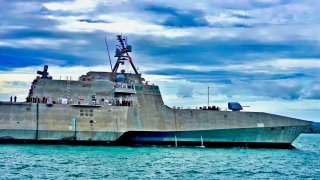The Rise and Fall of the U.S. Navy's Littoral Combat Ships
The U.S. Navy recently acquired the future USS Kingsville (LCS 36), the 18th Independence-variant Littoral Combat Ship, despite ongoing criticisms of the LCS program.
Summary: The U.S. Navy recently acquired the future USS Kingsville (LCS 36), the 18th Independence-variant Littoral Combat Ship, despite ongoing criticisms of the LCS program. Named after Kingsville, Texas, and built at Austal USA in Mobile, Alabama, its delivery underscores the Navy's commitment to these vessels. However, the program faces scrutiny due to the early retirement of ships, like the USS Independence and USS Freedom, and challenges such as operational limitations and reduced funding for mission modules. Critics question the LCS's fit within the Navy's broader strategic objectives, noting their vulnerability and inadequacy for certain combat roles, especially without the intended mission modules.
What the USS Kingsville Means for the Future of Littoral Combat Ships in the US Navy
The U.S. Navy on March 1 accepted delivery of the future USS Kingsville (LCS 36) at Austal USA's shipyard in Mobile, Alabama. The vessel is the 18th Independence-variant Littoral Combat Ship constructed, and it is named after Kingsville, Texas.
"The performance of Kingsville during this trial demonstrates a continuation of the standard of excellence in the LCS class as a whole. We are thrilled by the quality of the ship and the performance of our partners at Austal," said Jonas Brown, deputy program manager of the LCS program office. Brown was aboard LCS 36 throughout the trial events.
What Brown did not say is that even as the new LCS enters service, the Navy has already retired several Independence-class and Freedom-class LCS ships, with some having their service cut short by decades.
Nearly three years ago the Navy decommissioned the USS Independence (LCS-2) with little fanfare in a pierside ceremony in San Diego. The lead vessel of the U.S. Navy's Independence class left the fleet after just 11 years in service, far less than the expected 25-year lifespan the Navy envisioned for these fast-moving warships designed to operate close to shore. The USS Freedom (LCS-1) was also decommissioned in September 2021, decades ahead of schedule.
Littoral Combat Ship: The Wrong Program
The LCS program began when the U.S. military was engaged in the Global War on Terror. The LCS was seen as ideal for combating missile-firing boats and even small submarines. The stealthy surface combatants were also seen as a possible means to overcome anti-access and asymmetric threats in littoral or near-shore waters.The vessels were meant to emphasize speed. They could utilize flexible mission modules while operating in areas larger warships could not reach.
However, the ships have proven prone to breakdowns, and the U.S. Congress cut funding for the mission modules. This left the Navy with small and fast ships that were ill-suited to their original mission.
As a result, the vessels earned the moniker "Little Crappy Ships" from some sailors.
Critics of the program have further argued the LCS doesn't fit with long-term Navy fleet goals that emphasize aircraft carriers, destroyers, and other surface combatants. Naval officials first proposed retiring four LCSs in the service’s Fiscal Year 2021 budget submission.
Ideal for the Fight in the Red Sea – Not Quite
There were suggestions that some of the vessels be transferred to U.S. partners in the Middle East. Yet the Navy itself has shown such little confidence in the Littoral Combat Ship that none have been sent to the Red Sea to confront Houthi rebels.
The LCS should be ideal for patrolling the waters of the Red Sea, but that appears not to be the case. Without the mission modules, the vessels lack the weapons needed to head to almost any warzone.
"If the LCSs can't fight the Houthis, who can they fight? That likely answer is: no one," the UK's Telegraph newspaper opined in January.
As previously reported, part of the issue is that without the mission modules, the Littoral Combat Ships have no long-range air defenses and thus cannot protect themselves from Houthi missiles and drones. Moreover, with no long-range land-attack weapons, the LCSs can't strike back at Houthi positions in Yemen.
It is fair to ask how the small warships would fare against a larger and more sophisticated adversary such as China. Another reasonable question is why the Navy is still accepting brand new LCSs while it continues to retire the vessels years ahead of schedule. The U.S. already lacks the shipyards to build the warships and submarines it really needs. The Littoral Combat Ship should have been deep-sixed years ago.
Author Experience and Expertise: Peter Suciu
Peter Suciu is a Michigan-based writer. He has contributed to more than four dozen magazines, newspapers, and websites with over 3,200 published pieces over a twenty-year career in journalism. He regularly writes about military hardware, firearms history, cybersecurity, politics, and international affairs. Peter is also a Contributing Writer for Forbes and Clearance Jobs. You can follow him on Twitter: @PeterSuciu. You can email the author: [email protected].


